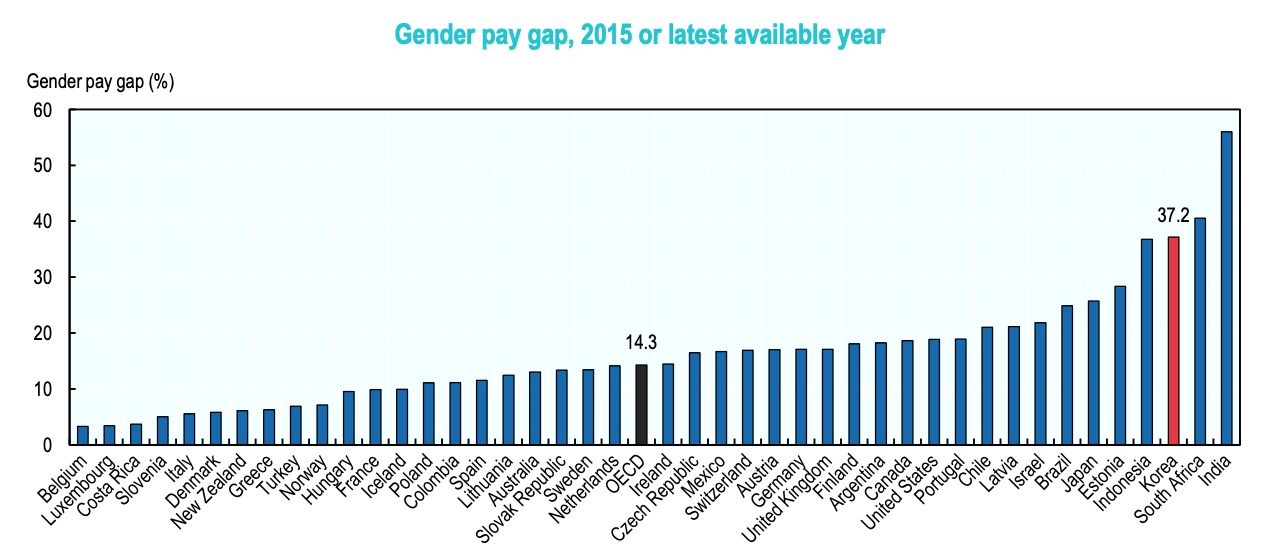We Don't Get to Choose
This Unit has been primarily about SDGs 3 (Health and Well-being) & 5. I chose to pursue my research in SDG 5, gender equality. Especially as someone who identifies as female, this problem is definitely something I am familiar with. Not only is this issue evident in the United States, but all over the world. Specifically, pay gaps related to gender. Continue reading to see how two very advanced countries have handled gender inequality, and what we can learn from their efforts.
Pay gaps, specifically related to gender, are still present in many countries today. Of course, you’ve probably heard the most common figure: “Women are paid every 82 cents for every dollar a man does.” Or at least if you live in the United States. Moreover, while South Korea may be one of the most technologically advanced countries, they also have had “ the highest gender pay gap for over 10 years among the member countries of OECD.” The issue of gender pay gaps is a global one, but why does it still exist in these “well developed” countries?

Pay gaps, specifically related to gender, are still present in many countries today. Of course, you’ve probably heard the most common figure: “Women are paid every 82 cents for every dollar a man does.” Or at least if you live in the United States. Moreover, while South Korea may be one of the most technologically advanced countries, they also have had “ the highest gender pay gap for over 10 years among the member countries of OECD.” The issue of gender pay gaps is a global one, but why does it still exist in these “well developed” countries?
(Pictured above is a graph depicting the gender pay gap in different countries. Please note the placement of the United States, South Korea, and the OECD average.)
When you take a look at some of the government’s efforts, however, the state of today’s gender equality problem becomes more clear. According to Time Magazine, “Since taking control of the White House, however, Trump has made a number of moves that critics say could harm pay equity. In 2017, he stopped an Obama-era rule meant to address the wage gap...” Conversely, the first piece of legislation Barak Obama signed into law, the Lilly Ledbetter act, “empowers workers to recover wages lost due to discrimination,” (Obama White House Archives). And due to the conflicted nature of Democrats and Republicans, it makes sense why insufficient progress is being made right now.
South Korea has also had conflicting efforts to achieve gender equality. But just in terms of the workforce, barely half of the women are employed in Korea (56%), and “many women withdraw from work when they have children,” (OECD). As they described by OECD, “an uphill battle,” President Moon Jae-in also “fulfilled his promise by appointing six women to minister positions, comprising 32% of the Cabinet, more than any previous administration.”
It seems as though there are some notable differences in both countries’ agendas for addressing the gender wage gap. While the U.S and South Korea are both exceedingly advanced and developed countries, in correlation to extensive power, they also have the responsibility of handling gender wage gaps. With this in mind, the U.S and South Korea have handled these issues a bit differently. Currently, it doesn’t seem as though the gender pay gap is a real concern to our president. In fact, when asked about the issue in 2015, he responded, “[i]f you start to say everybody gets equal pay, you get away from the whole American Dream.” And while South Korea’s wage gap is the worst among OECD, President Moon Jae-In has made several efforts to combat the trend of more than a decade of high gender wage gaps. However, there is still a long way to go, and South Korea tends to focus more on gender inequality as a whole than the wage gap in particular.
Inequality will continue unless we call out indications of unjust behavior. It needs to be talked about, especially since no one gets to choose what they are born as.
Works Cited
Abrams, Abigail. “What the 2020 Candidates Have Said and Done About Equal Pay.” Time, Time, 2 Apr. 2019, time.com/5562209/equal-pay-day-2020-candidates/.
Graf, Nikki, et al. “The Narrowing, but Persistent, Gender Gap in Pay.” Pew Research Center, Pew Research Center, 14 Aug. 2020, www.pewresearch.org/fact-tank/2019/03/22/gender-pay-gap-facts/.
Paul Hastings LLP, www.paulhastings.com/genderparity/countries/korea.html.
Roh, Joori. “With Plan to Show Women More Respect, South Korea Tries to Fix Its Demographic Crisis.” The Japan Times, www.japantimes.co.jp/news/2019/01/04/asia-pacific/social-issues-asia- pacific/plan-show-women-respect-south-korea-tries-fix-demographic-crisis/.
PDFs
https://www.oecd.org/korea/Gender2017-KOR-en.pdf
https://digitalcommons.bard.edu/cgi/viewcontent.cgi?article=1267&context=senproj_s2016
https://obamawhitehouse.archives.gov/sites/default/files/docs/equal_pay_issue_brief_final.pdf
South Korea has also had conflicting efforts to achieve gender equality. But just in terms of the workforce, barely half of the women are employed in Korea (56%), and “many women withdraw from work when they have children,” (OECD). As they described by OECD, “an uphill battle,” President Moon Jae-in also “fulfilled his promise by appointing six women to minister positions, comprising 32% of the Cabinet, more than any previous administration.”
It seems as though there are some notable differences in both countries’ agendas for addressing the gender wage gap. While the U.S and South Korea are both exceedingly advanced and developed countries, in correlation to extensive power, they also have the responsibility of handling gender wage gaps. With this in mind, the U.S and South Korea have handled these issues a bit differently. Currently, it doesn’t seem as though the gender pay gap is a real concern to our president. In fact, when asked about the issue in 2015, he responded, “[i]f you start to say everybody gets equal pay, you get away from the whole American Dream.” And while South Korea’s wage gap is the worst among OECD, President Moon Jae-In has made several efforts to combat the trend of more than a decade of high gender wage gaps. However, there is still a long way to go, and South Korea tends to focus more on gender inequality as a whole than the wage gap in particular.
Inequality will continue unless we call out indications of unjust behavior. It needs to be talked about, especially since no one gets to choose what they are born as.
Works Cited
Abrams, Abigail. “What the 2020 Candidates Have Said and Done About Equal Pay.” Time, Time, 2 Apr. 2019, time.com/5562209/equal-pay-day-2020-candidates/.
Graf, Nikki, et al. “The Narrowing, but Persistent, Gender Gap in Pay.” Pew Research Center, Pew Research Center, 14 Aug. 2020, www.pewresearch.org/fact-tank/2019/03/22/gender-pay-gap-facts/.
Paul Hastings LLP, www.paulhastings.com/genderparity/countries/korea.html.
Roh, Joori. “With Plan to Show Women More Respect, South Korea Tries to Fix Its Demographic Crisis.” The Japan Times, www.japantimes.co.jp/news/2019/01/04/asia-pacific/social-issues-asia- pacific/plan-show-women-respect-south-korea-tries-fix-demographic-crisis/.
PDFs
https://www.oecd.org/korea/Gender2017-KOR-en.pdf
https://digitalcommons.bard.edu/cgi/viewcontent.cgi?article=1267&context=senproj_s2016
https://obamawhitehouse.archives.gov/sites/default/files/docs/equal_pay_issue_brief_final.pdf

Comments
Post a Comment